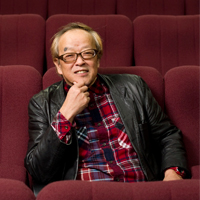Title of Presentation
“When Human Performance Disappears from Movies”
At the Academy Awards in the United States, there is a separate, independent category for animation, but in Japan’s Best Ten and other movie awards, animated films are regarded in the same light as other films. As someone who has made a career directing live-action films (in Japanese we call this “actual-image film”), I feel a bit uneasy when my films are mentioned alongside animated films. This is certainly not based on any sense of arrogance, but rather because of the fact that there is no acting in animation.
I perceive acting in a movie to entail the director, who is the producer of the movie, conveying what he or she wants to have actors express, and the actors, as the performers, portraying those ideas through their expressions, phrasing, body movements, mannerisms, and so on. In animated films, there are no actors. By animating the image that is the character, it is the producer of the movie who creates the performance. Although there are exceptions, most directors basically are not able to act and instead their talent is to draw the performance they want out of the actors. In animation, perhaps the director has the talent of dreaming up the performance.
This introduction has gotten a bit long, but the topic I will speak about here is not animated films, which is outside my area of expertise, but rather about performances in monster movies—a genre I have been involved with in a number of films. Traditionally, Japanese movie monsters are played by Human Beings who get inside of molded monster costumes—so-called kigurumi—and destroy a miniature town, crash through the sea, and smash mountains. In these cases, the monster is a performer, and the fact that the monster performs according to the demands of the special effects director, who is the producer, follows the basic principles of movie performances.
These traditional Japanese monster performances are widely recognized and have won a high level of support from people around the world. I am also one of those supporters. However, in monster movies of recent years, it has become mainstream for films made overseas, where the kigurumi tradition does not exist, as well as in Japan, to create the entity of the monster through CGI and make it move through computer programming. As a result, there is no longer a need for miniature towns. The monster can move freely through scenes of actual cities, oceans, and mountains, and can achieve previously impossible expressions and movements. The view has taken hold that this has given rise to a new level of realism and power. I am not denying that assessment, and yet if the monster is a living thing, shouldn’t the role of the monster be a performance? And if so, then shouldn’t the principle of producer and performer be upheld?
Profile
- A brief Biography
-
Born in 1952 in Osaka. Graduate of Kyoto Prefectural University of Medicine. Omori began making 8mm films in high school, and in 1977 his scenario for Orange Road Express won the Kido Prize. The following year, he made his theatrical debut as a director with the film adaption of that scenario. Since then, he has gone on to make about thirty films, including Disciples of Hippocrates (director/screenplay) in 1980, which depicted his own time as a medical student; an adaptation of Haruki Murakami’s novel, Hear the Song of the Wind (director/screenplay), in 1981; and Young Girls in Love and Totto Channel (director/screenplay for both), for which he received the New Face Award of the Minister of Education Award for Fine Arts in 1988. From 1989, he began working on the Heisei Godzilla series, writing and directing Godzilla vs. Biollante and Godzilla vs. King Ghidrah, and writing two other screenplays as well. He also directed Shoot! (1994), featuring SMAP; wrote and directed Emergency Call (1995); directed Kenji Miyazawa Story (1996); and wrote and directed Those Were the Days (2006). His most recent work was the 2015 feature, Blowing in the Winds of Vietnam, a joint Japanese-Vietnamese production that was also released in Vietnam. Since 2006, he has served as the head of the Visual Concept Planning Department at Osaka University of Arts (which has produced a number of young directors of Japanese movies in recent years), where he is training young filmmakers. Omori is also on the board of the Directors Guild of Japan.
- Details of selected Awards and Honors
-
1988 New Face Award of the Minister of Education Award for Fine Arts for Young Girls in Love and Totto Channel (director/screenplay) 1997 Kido Prize for the scenario of Orange Road Express - A list of selected Publications
-
1977 Orange Road Express (scenario) 1980 Disciples of Hippocrates (director/screenplay) 1981 Adaptation of Haruki Murakami’s Hear the Song of the Wind (director/screenplay) 1988 Young Girls in Love and Totto Channel (director/screenplay) 1992 Godzilla vs. Mothra (screenplay) 1994 Shoot! (director) 1995 Godzilla vs. Destroyah (screenplay) 1995 Emergency Call (director/screenplay) 1996 Kenji Miyazawa Story (director) 2006 Those Were the Days (director/screenplay) 2015 Joint Japan-Vietnam production: Blowing in the Winds of Vietnam (director/screenplay)






